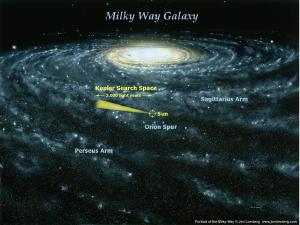Blog
One in a Billion
13 November 2013

Yesterday I talked about how some of Kepler’s data can be a bit puzzling, but there are lots of results from Kepler that are very clear. After all, we now have more than a thousand confirmed exoplanets, many of which are from Kepler data. This means we have enough planets to run a bit of statistics, and it leads to some interesting results. For example, an article was published this month in the Proceedings of the National Academy of Sciences (PNAS) analyzing the statistical distribution of known exoplanets from the Kepler data.1 This article is open access (woot!) and you can read it here.
The focus of the paper was Earth-like worlds. The authors defined “Earth-like” as meeting three conditions:
First, the star the planet orbits must be Sun-like, meaning it must be a G or K type main sequence star. The Sun is a G-type star, and K-type stars are a bit smaller than our Sun. This criteria excludes M-type main sequence stars (red dwarfs) which are much more common, but not very Sun-like.
Second, the planet must have a diameter between 1 – 2 times that of Earth. Because Kepler discovers planets that pass in front of a star, it is easier to determine a planet’s size than its mass. But it is reasonable to assume that a planet about the same size as Earth will have a mass similar to Earth.
Third, the orbital period of the planet must be between 200 and 400 days. This is a rough way of saying the planet is in the “habitable zone” of its star. Very roughly, we can say the Sun’s habitable zone is bounded by the orbits of Venus and Mars. Venus has an orbital period of 225 days, and Mars 687 days. Since the K-class stars are a bit smaller and cooler than the Sun, the 200 – 400 day range is a reasonable measure of potentially habitable zone.
One of the challenges of doing statistics is making sure you account for biases in your data. In exoplanet data there are two potential biases. The first is that larger planets in closer orbits are easier to find than smaller planets in farther orbits. Another is that planets that could potentially be observed are missed because of noise in the data. We find the easy signals, but miss the hard ones.
To account for the first bias, the authors looked at data from 42,000 Sun-like stars, finding 603 planets. From this they were able to look at the distribution of planetary distances observed and extrapolated the data to larger distances. To account for the second bias the authors put fake planetary signals into the Kepler data and then tried to “discover” those signals in the data. From that they could get a handle on how many planets are “missed” in the real data. With a handle on those potential biases, the authors could calculate the fraction of Sun-like stars with Earth-like planets in their habitable zones.
The results are pretty surprising. Based on the statistics, it’s estimated that between 14% and 30% of G and K type stars have Earth-sized planets in their habitable zone. There are about 300 billion stars in our galaxy, and about 60 billion of them are G and K type stars. That means there is somewhere between 8 to 20 billion potentially habitable Earth-like worlds in our galaxy alone.
It’s hard to wrap your head around those kind of numbers, so here is another way of looking at it. Suppose the Earth were a big blue marble. Suppose all the other potentially habitable “earths” were marbles of a similar size. If you put Earth and all the other marbles in a single container, there would be enough to fill a volume roughly the size of the great pyramid at Giza.
It is important to note that these are “potentially” habitable, meaning that they are at a distance where temperatures could allow for things like liquid water. That doesn’t mean they are habitable, or that they have life. Many could be dry planets like Venus, or have atmospheres that are too thin to support life. It is possible that most of them are warm and wet like Earth, or that none of them are. Right now we just don’t know.
But we do know the potential is there. The potential of billions of earths in our galaxy alone, and there are about 100 billion galaxies in the observable universe.
That’s a lot of worlds waiting to be explored.
Petigura, Erik A., Andrew W. Howard, and Geoffrey W. Marcy. “Prevalence of Earth-size planets orbiting Sun-like stars.” Proceedings of the National Academy of Sciences 110.48 (2013): 19273-19278. ↩︎